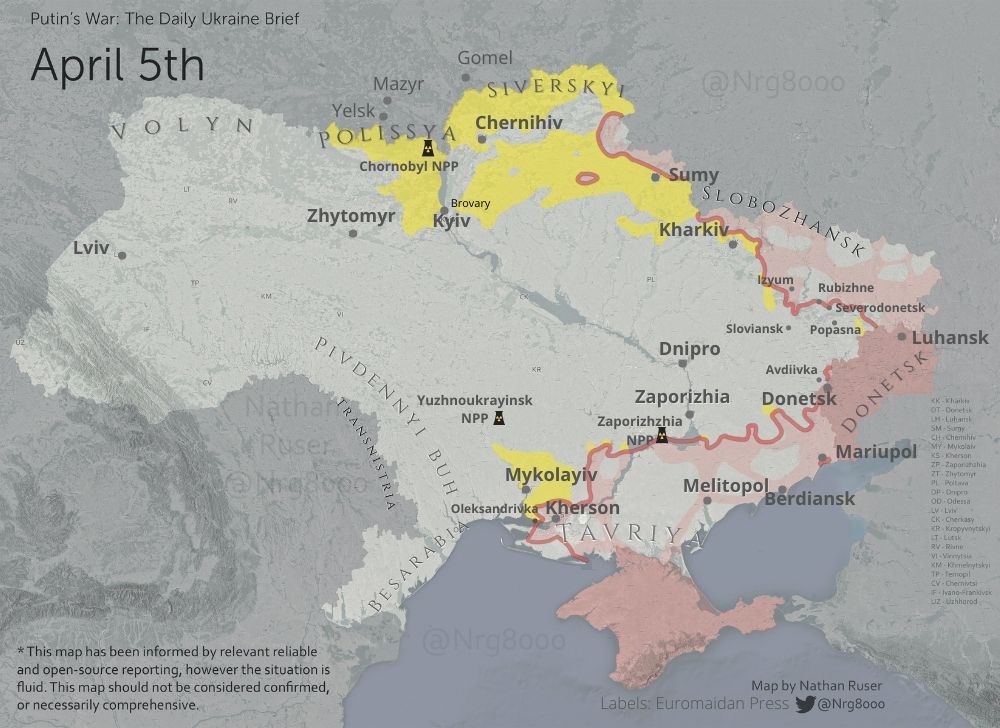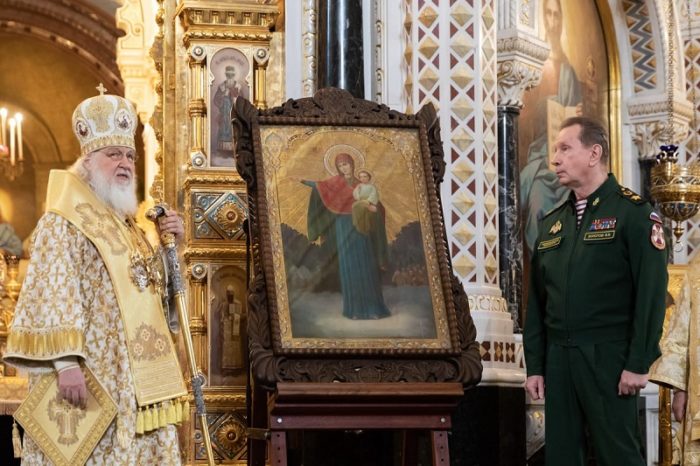I spent two weeks in Donbas, a full-scale war zone. I spoke to many military men of different ranks. We discussed both the Russian and Ukrainian military strategies during this war. All of them had their own point of view about the course of events. I decided to compile down everything I’ve heard in one text.
It’s no secret that the Russians were going to seize the capital of Ukraine, Kyiv, within 72 hours, and in 21 days they planned to destroy the whole Ukrainian army and announce Ukraine’s total surrender.
The Russians initially launched an offensive based on archaic Soviet military perceptions. Namely, they started the offensive from multiple fronts, attempting to encircle Ukrainian forces. For example, they were moving from Crimea, aiming to seizing Kherson and Melitopol; from the territory of Belarus in the direction of Chernihiv and Kyiv; from the Sumy Oblast to Kyiv and Kharkiv, and finally from the territory of the so-called “LDNR” (Luhansk People’s Republic and Donetsk People’s Republic, collectively, two occupied regions of Ukraine) to Kharkiv and unoccupied territory of Donbas.
At the same time, Russians tried to carry out an air assault, landing its troops at Hostomel airfield as well as Vasylkiv air base, just 25 km away from Kyiv. None of their plans worked out: Russia lost the battles, being wiped out by the Ukrainian army. So they had to develop a contingency plan.
Strategy at the beginning of the war
In the first stage, 24 February – 5 April, the Russians concentrated all their efforts to seize Kyiv. However, they fell victim to outdated Soviet warfare approaches. Ukrainian soldiers tactically retreated, and thus maximally drew Russian troops into the depths of the country. When the supply lines of Russian troops stretched for more than 100 km, Ukraine’s Special Operation Forces together with the Armed Forces of Ukraine’s artillery started destroying convoys with fuel supply. Without fuel, the Soviet military equipment (tanks and armored personnel carriers) were turned into a useless pile of metal.

After a month of tense fighting near Kyiv, the Russian forces sustained huge losses in personnel and equipment. Their military leadership understood that after a month or two of such battles they could lose all their combat-ready army. Therefore, Russian troops were ordered to withdraw from the territory of Kyiv, Sumy, and Chernihiv oblasts.
To cut a long story short, the Russians failed in the Battle of Kyiv due to their long “logistical leg.” They are simply unable to fight without the use of a railway. The depth of their advance depends on the presence of iron tracks. If there is no railway, the Russian military cannot carry out its operational and tactical tasks.
Like Napoleon’s 1812: why Russian troops retreated from northern Ukraine
In the second stage, after 5 April, Russians announced a significantly less ambitious goal – to fully seize Donbas. Russians deployed units that were withdrawn from the territory of Kyiv to strengthen its group of troops in this direction. So, the main front was the offensive on Izium in the Kharkiv region and Huliaipole in the Zaporizhzhia region. These joint actions aimed to take control over the Ukrainian army based in Donetsk and Luhansk oblasts.
Even though the Russians managed to take Izium, they still could not make decisive progress and move forward, not to mention that their offensive near Huliaipole failed even to start. The Ukrainian artillery and aviation that Russians claimed was "eliminated" in the first days of the war was constantly destroying Russian equipment convoys. Russian soldiers were again stuck in local battles.
So, considering the significant losses, the Russians had to adjust their military strategical plans. Now they want to seize at least the Luhansk Oblast. To do that, they need to take control over 2 cities – Sievierodonetsk and Lysychansk. Intense battles have continued since the beginning of the Russian invasion, but the Ukrainian military tactically retreated to new lines of defense. Battles for Sievierodonetsk started in the middle of April.
Russia's change of strategy
After the defeat in the battle for Kyiv, the Russians significantly changed their strategic plans. If earlier they just wanted to capture the territory of Ukraine, now they attempt to destroy the Ukrainian army in the bloody battles in Donbas, because this is the location of most combat-capable Ukrainian military units were located.
Russians do everything possible to “grind” through the most experienced Ukrainian contract servicemen on the battlefield. Ukraine will not be able to quickly replace these personnel losses with equally experienced people that have a proper military background. This will sooner or later lead to the collapse of Ukraine's defense.
At the same time, this strategy has its disadvantages, because the Russian army is also suffering significant losses among its experienced combatants. Ukrainians are massively destroying experienced Russian pilots, tankers, and paratroopers; it is very unlikely that the Russians will be able to find proper replacements quickly.
In Donbas, Russians kept shooting themselves in the foot, as they did in the first stage of the war – trying to advance from different fronts.
- a short “logistical leg”;
- peculiarities of the landscape;
- an advantage in weapons and ammunition.
1. Logistics
So, let's start with the first key factor – logistics.
When Russians were attacking Kyiv from the territory of Belarus via the Sumy and Chernihiv oblasts, they had to use regular roads. Ukrainian soldiers were blowing up bridges, arranging ambushes, and destroying convoys carrying fuel and lubricants. As a result, Russian soldiers were cut off from the on-time delivery of everything needed and finally failed with their plan to seize the capital of Ukraine.
In Donbas, the situation is radically different. The Russians use the railway in the Russian proxy Luhansk and Donetsk "republics," occupied since 2014, to deliver military equipment, ammunition, and personnel. It enables them to draw on their military reserve, and ensure the stable work of artillery regardless of the quality of the roads and weather conditions.
2. Landscape
The second is the peculiarities of the landscape. Compared to the wooded area in northern Ukraine, Donbas has mostly flat terrain and large urban areas. This means that here the Ukrainian army can't benefit from the concealment and protection of forests like in the first stage of the war. The only place where Ukrainian soldiers can consolidate are cities, but Russians keep striking at Ukrainian cities with massive artillery.
3. Numbers
The third factor is the Russians' huge advantage in terms of the amount of artillery together with multiple rocket launchers. However, even here their successes are still far from what they expected to achieve. After all, after three months of full-scale war, they managed to move 30-40 km forward. You can hardly call it a great success.
Ukraine's new tactic
The Ukrainian Army is also applying a new tactic. Even though Russia outnumbers Ukraine in manpower and weapons, they suffer many tactical defeats in Eastern Ukraine. For instance, the Armed Forces of Ukraine allowed Russians enter Sievierodonetsk, and then started to systematically destroy their best units in street battles. As a result, the Russians were trapped, since they were both stuck in an unknown city and deprived of their own artillery support. Also, Russian artillery now is very inaccurate and the probability for Russians to hit their own people is quite big. So now Russians have no idea what to do with Sievierodonetsk. They failed to take the city in one fell swoop, but they could not bypass it.
Therefore, the Russians are forced to keep a huge grouping of troops in this direction. One more factor starting to play a key role is military aid from the West, such as modern heavy artillery systems. The effectiveness of Western artillery compared to Soviet-type equipment, with which both Ukrainian and Russian forces are armed with, is just tremendous.
For example, it took more than 400 artillery shells and 3 hours of work for Ukrainian Soviet-type artillery to destroy a Russian pontoon bridge and over 70 items of armored vehicles near Bilohorivka village, not far from Sievierodonetsk. At the same time, the Ukrainian battalion equipped with American howitzers M777 used more than 100 artillery shells and 20 minutes to destroy a similar pontoon and the same number of vehicles. The difference is obvious.
Russian troops suffer epic fail while attempting to cross river at Bilohorivka
The Siverskyi Donets river plays a big role in the enemy's deterrence, serving as a natural barrier for the Russian offensive. As it turned out, it is a big problem for Russia to cross the river. They simply do not know how to do that.
Now, a few words about the Harpoon anti-ship missiles, which were ostensibly intended to solve the Russian blockade of Ukrainian seaports that may lead to a world food crisis. It is unlikely that “Harpoons” will solve this problem since they can strike only naval targets while Russians also have submarines and aviation capable of destroying convoys with grain.
Finally, Putin seeks to create a precedent that would help him mobilize the entire male population of the "LDNR" to Russia's war under the pretext of protecting their “homeland” and the “Russian world.”
Meanwhile, in the occupied territories, Russia is simply engaging in the systematic practice of terror in order to ultimately demoralize the people living there and shift the blame for war crimes committed by the Russian army to Ukraine. Massive shelling, resulting in destruction and human casualties, is evidence that Russia doesn’t care about these people: Putin sees them as “expendables” on a path to achieving his imperial goals, and the last thing Russia is going to do is protect them. However, it is due to Russia that these “republics” are facing a demographic catastrophe, destruction of infrastructure, outflow of refugees, and evaporation of the last remaining economic capacities.
Anyway, the bitter truth is better than sweet lies. While the West is starting to feel Ukrainian fatigue, Russia continues the devastating war in Ukraine with no intention to sit down at the negotiating table. Yet the Ukrainian army is bravely defeating and restraining Russia.
Related:
- Like Napoleon’s 1812: why Russian troops retreated from northern Ukraine
- Battle of Donbas: Russian attempt to encircle Ukrainian troops, in maps
- Russian troops suffer epic fail while attempting to cross river at Bilohorivka
- Why Ukraine needs rocket artillery to win the war








